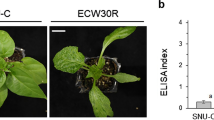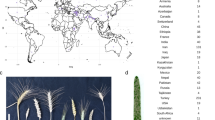Abstract
Insertion/deletion (InDel) polymorphisms are generally irreversible and, thus, are useful for evaluating the genetic relationships within the genus Oryza. Moreover, subspecies-specific (SS) InDel markers linked to conserved genomic regions specific to the indica and japonica subspecies of Oryza sativa can provide insight into the genetic relationships between cultivated and wild rice. The evolutionary relationship among Oryza species in respect to their indica and japonica alleles was investigated using 67 selected indica–japonica InDel SS-STS primers across 290 accessions, including 61 Asian cultivated rice (O. sativa) cultivars, 27 African cultivated rice (O. glaberrima) accessions, and 202 accessions of wild Orzya species. The average SS allele frequency of the various Oryza species, from AA-genome to BB ~ EE, and FF ~ HHKK showed an increased proportion of non-O. sativa and null alleles in the more distantly related wild species. Most of the wild species, except the more distant EE, GG, HHJJ, and HHKK genome accessions, consisted of relatively more indica than japonica alleles of SS markers. To validate the SS-STS study, PCR products of nine markers were sequenced across 24–33 accessions. Sequencing results revealed that Oryza species share indica or japonica-like conserved InDel regions even across the different genomes. The presence of some japonica alleles beyond the AA genome at some SS InDel loci also suggests that japonica-specific alleles occurred early in the history of the Oryza genus. The O. sativa sub-species specific markers thus provide further insight into the evolutionary pathway in the genus Oryza and the process of differentiation between indica and japonica.





Similar content being viewed by others
References
Brar DS, Khush GS (2002) Transferring genes from wild species into rice. In: Kang MS (ed) Quantitative genetics, genomics, and plant breeding. CAB International, Wallingford, pp 197–217
Chang TT (1976) The origin, evolution, cultivation, dissemination, and diversification of Asian and African rices. Euphytica 25:425–441
Cheng C, Motohashi R, Tsuchimoto S, Fukuta Y, Ohtsubo H, Ohtsubo E (2003) Polyphyletic origin of cultivated rice: based on the interspersion pattern of SINEs. Mol Biol Evol 20:67–75
Chin JH, Kim HH, Jiang WZ, Chu SH, Woo MO, Han LZ, Brar DS, Koh HJ (2007) Identification of subspecies-specific STS markers and their association with segregation distortion in rice (Oryza sativa L.). J Crop Sci Biotech 10:175–184
Degenkolbe T, Do PT, Zuther E, Repsilber D, Walther D, Hincha DK, Köhl K (2009) Expression profiling of rice cultivars differing in their tolerance to long-term drought stress. Plant Mol Biol 69:133–153
Edwards JD, Lee VM, McCouch SR (2004) Sources and predictors of resolvable indel polymorphism assessed using rice as a model. Mol Gen Genomics 271:298–307
Feltus FA, Wan J, Schulze SR, Estill JC, Jiang N, Paterson AH (2004) An SNP resource for rice genetics and breeding based on subspecies Indica and Japonica genome alignments. Genome Res 14:1812–1819
Fuller DQ (2007) Contrasting patterns in crop domestication and domestication rates: recent archaeobotanical insights from the Old World. Ann Bot-Lond 100:903–924
Garris AJ, Tai TH, Coburn J, Kresovich S, McCouch S (2005) Genetic structure and diversity in Oryza sativa L. Genetics 169:1631–1638
Hamdi H, Nishio H, Zielinski R, Dugaiczyk A (1999) Origin and phylogenetic distribution of Alu DNA repeats: irreversible events in the evolution of primates. J Mol Biol 289:861–871
Huang X, Kurata N, Wei X, Wang ZX, Wang A, Zhao Q, Zhao Y, Liu K, Lu H, Li W, Guo Y, Zhou C, Fan D, Weng Q, Zhu C, Huang T, Lei Zhang, Wang Y, Feng L, Furuumi H, Kubo T, Miyabayash T, Yuan X, Xu Q, Dong G, Zhan Q, Li C, Fujiyama A, Toyoda A, Lu T, Feng Q, Qian Q, Li J, Han B (2012) A map of rice genome variation reveals the origin of cultivated rice. Nature 490:497–501
Izawa T (2008) The process of rice domestication: a new model based on recent data. Rice 1:127–134
Jacquemin J, Bhatia D, Singh K, Wing RA (2013) The International Oryza Map Alignment Project: development of a genus-wide comparative genomics platform to help solve the 9 billion-people question. Curr Opin Plant Biol 16:147–156
Kim BS, Jiang W, Koh HJ (2009) Genetic diversity of rice collections using subspecies-specific STS markers. Korean J Breed Sci 41:101–105
Kovach MJ, McCouch SR (2008) Leveraging natural diversity: back through the bottleneck. Curr Opin Plant Biol 11:193–200
Kovach MJ, Sweeney MT, McCouch SR (2007) New insights into the history of rice domestication. Trends Genet 23:578–587
Li C, Zhou A, Sang T (2006) Genetic analysis of rice domestication syndrome with the wild annual species, Oryza nivara. New Phytol 170:185–194
Liu K, Muse SV (2005) PowerMarker: an integrated analysis environment for genetic marker analysis. Bioinformatics 21:2128–2129
Londo JP, Chiang YC, Hung KH, Chiang TY, Schaal BA (2006) Phylogeography of Asian wild rice, Oryza rufipogon, reveals multiple independent domestications of cultivated rice, Oryza sativa. Proc Natl Acad Sci USA 103:9578–9583
Lu F, Ammiraju JSS, Sanyalc A, Zhanga S, Song R, Chena J, Lia G, Suia Y, Song X, Chenga Z, de Oliveira AC, Bennetzen JL, Jackson SA, Wing RA, Chena M (2009) Comparative sequence analysis of MONOCULM1-orthologous regions in 14 Oryza genomes. Proc Natl Acad Sci USA 106:2071–2076
Ma J, Bennetzen JL (2004) Rapid recent growth and divergence of rice nuclear genomes. Proc Natl Acad Sci USA 101:12404–12410
Marathi B, Ramos J, Hechanova SL, Oane RH, Jena KK (2015) SNP genotyping and characterization of pistil traits revealing a distinct phylogenetic relationship among the species of Oryza. Euphytica 201:131–148
McCouch SR, Sweeney M, Li J, Jiang H, Thomson M, Septiningsih E, Edwards J, Moncada P, Xiao J, Garris A, Tai T, Martinez C, Tohme J, Sugiono M, McClung A, Yuan LP, Ahn SN (2007) Through the genetic bottleneck: O. rufipogon as a source of trait-enhancing alleles for O. sativa. Euphytica 154:317–339
Molina J, Sikora M, Garud N, Flowers JM, Rubinstein S, Reynolds A et al (2011) Molecular evidence for a single evolutionary origin of domesticated rice. Proc Natl Acad Sci USA 108:8351–8356
Nishikawa T, Vaughan DA, Kasdowaki KI (2005) Phylogenetic analysis of Oryza species, based on simple sequence repeats and their flaking nucleotide sequences from the mitochondrial and chloroplast genomes. Theor Appl Genet 1100:696–705
Pal S, Jain S, Jain RK (2001) DNA isolation from milled rice samples for PCR based molecular marker analysis. Rice Genet News 18:94
Purugganan MD (2010) The evolution of rice: molecular vignettes on its origins and spread. Archaeol Anthropol Sci 2:61–68
Rogozin IB, Thomson K, Csürös M, Carmel L, Koonin EV (2008) Homoplasy in genome-wide analysis of rare amino acid replacements: the molecular-evolutionary basis for Vavilov’s law of homologous series. Biol Direct 3:7
Rokas A, Holland WH (2000) Rare genomic changes as a tool for phylogenetics. TREE 15:454–459
Sang T, Ge S (2007) Genetics and phylogenetics of rice domestication. Curr Opin Genet Dev 17:533–538
Sang T, Ge S (2013) Understanding rice domestication and implications for cultivar improvement. Curr Opin Plant Biol 16:139–146
Stec I, Nagl SB, Ommen GJBV, Dunnen JTD (2000) The PWWP domain: a potential protein-protein interaction domain in nuclear proteins influencing differentiation? FEBS Lett 473:1–5
Sweeney M, McCouch SR (2007) The complex history of the domestication of rice. Ann Bot 100:951–957
Tamura K, Peterson D, Peterson N, Stecher G, Nei M, Kumar S (2011) MEGA5: molecular evolutionary genetics analysis using maximum likelihood, evolutionary distance, and maximum parsimony methods. Mol Biol Evol 28:2731–2739
Temnykh S, Park WD, Ayres N, Cartinhour S, Hauck N, Lipovich L, Cho YG, Ishii T, McCouch SR (2000) Mapping and genome organization of microsatellite sequences in rice (Oryza sativa L.). Theor Appl Genet 100:697–712
Thomson MJ, Zhao K, Wright M, McNally KL, Rey J, Tung CW, Reynolds A, Scheffler B, Eizenga G, McClung A, Kim H, Ismail AM, de Ocampo M, Mojica C, Reveche MY, Dilla-Ermita CJ, Mauleon R, Leung H, Bustamante C, McCouch SR (2012) High-throughput single nucleotide polymorphism genotyping for breeding applications in rice using the BeadXpress platform. Mol Breed 29:875–886
Vaughan DA, Morishima H, Kadowaki K (2003) Diversity in the Oryza genus. Curr Opin Plant Biol 6:139–146
Vaughan DA, Kadowaki K, Kaga A, Tomooka N (2005) On the phylogeny and biogeography of the Genus Oryza. Breed Sci 55:113–122
Vaughan DA, Balas ZS, Heslop-Harrison JS (2007) From crop domestication to super-domestication. Ann Bot 100:893–901
Vaughan DA, Lu BR, Tomooka N (2008a) Was Asian rice (Oryza sativa) domesticated more than once? Rice 1:16–24
Vaughan DA, Lu BR, Tomooka N (2008b) The evolving story of rice evolution. Plant Sci 174:394–408
Vitte C, Ishii T, Lamy F, Brar D, Panaud O (2004) Genomic paleontology provides evidence for two distinct origins of Asian rice (Oryza sativa L.). Mol Genet Genomics 272:504–511
Wang MX, Zhang HL, Zhang DL, Qi YW, Fan ZL, Li DY, Pan DJ, Cao YS, Qiu ZE, Yu P, Yang QW, Wang XK, Li ZC (2008) Genetic structure of Oryza rufipogon Griff. in China. Heredity 101:527–535
Xie X, Molina J, Hermamadez R, Reynolds A, Boyko AR, Bustamanta CD, Purugganan MD (2011) Levels and patterns of nucleotide variation in domestication STL regions on rice chromosome 3 suggest lineage specific selection. PLoS ONE 6:e20670
Yang CC, Kawahara Y, Mizuno H, Wu J, Matsumoto T, Itoh T (2012) Independent domestication of Asian rice followed by gene flow from japonica to indica. Mol Biol Evol 29:1471–1479
Zhao K, Wright M, Kimball J, Eizenga G, McClung A, Kovach M, Tyagi W, Ali ML, Tung CW, Reynolds A, Bustamante CD, McCouch SR (2010) Genomic diversity and introgression in O. sativa reveal the impact of domestication and breeding on the rice genome. PLoS ONE 5:e10780
Zong Y, Chen Z, Innes JB, Chen C, Wang Z, Wang H (2007) Fire and flood management of coastal swamp enabled first rice paddy cultivation in east China. Nature 449:459–462
Acknowledgments
This work was supported by a grant from the Next-Generation BioGreen 21 Program (Plant Molecular Breeding Center, No. PJ01102401), Rural Development Administration, Republic of Korea and support from the Global Rice Science Partnership (GRiSP) to the International Rice Research Institute. The authors thank Christine Jade Dilla-Ermita, Joie Ramos and Eleazar Manalaysay for providing technical support.
Author information
Authors and Affiliations
Corresponding authors
Ethics declarations
Conflict of interest
The authors declare that they have no conflict of interest.
Human and animal rights
This research does not involve human participants or animals.
Additional information
Joong Hyoun Chin and Yoo-Jin Lee have contributed equally to this paper.
Electronic supplementary material
Below is the link to the electronic supplementary material.
Rights and permissions
About this article
Cite this article
Chin, J.H., Lee, YJ., Jiang, W. et al. Characterization of indica–japonica subspecies-specific InDel loci in wild relatives of rice (Oryza sativa L. subsp. indica Kato and subsp. japonica Kato). Genet Resour Crop Evol 64, 405–418 (2017). https://doi.org/10.1007/s10722-016-0368-1
Received:
Accepted:
Published:
Issue Date:
DOI: https://doi.org/10.1007/s10722-016-0368-1




